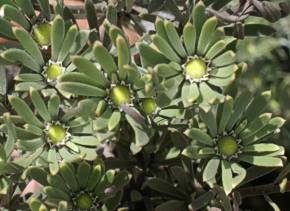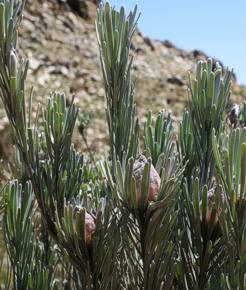Leucadendron album
Leucadendron album (Thunb.) Fourc.
Family: Proteaceae
Common names: linear-leaf conebush (Eng.); aarbeisilwertolbos (Afr.)
Introduction
An unusual conebush, with its velvety silver foliage, Leucadendron album is a striking mountain fynbos shrub.

Description
Description
Leucadendron album is an erect, evergreen, silvery shrub with a neat habit, 1.5-2.0 m tall. It grows from a single basal stem. It has lush silver foliage. The leaves are linear to linear-oblanceolate with short, silvery hairs. The male and female flowers on separate plants.The involucral bracts which surround the flower head are larger than the leaves and are longer than the flower head. Flowers are yellow and have a faint, but pleasant smell. The cone is ovoid, silvery peach, and the seeds are retained inside the cone until released after fire. Flowering time: December.
Specimens from the Swartberg Mountains have wider leaves.

Conservation Status
Status
Not threatened.
Distribution and habitat
Distribution description
The linear-leaf conebush occurs on well-drained sandstone slopes on the Swartberg, Langeberg, Outeniqua and Tsitsikamma Mountains. from Swellendam to Uitenhage. It occurs in locally abundant stands at altitudes of 1100-2000 m.
Derivation of name and historical aspects
History
The cone of Leucadendron album looks much like that of a young protea bud, so much so, that when Thunberg first discovered it, he mistook it for such and called it Protea alba. When his mistake was later discovered, the name was changed to Leucadendron aurantiacum, but the valid name is L. album.
Leucadendron, pronounced loo-ka-den-dron, gains its origins from the Greek word leucos meaning white, and dendron meaning a tree, referring to the silver tree, Leucadendron argenteum. Its species name is derived from the Latin word, album meaning white.

Ecology
Ecology
Flowers are pollinated by wind. The female cones retain the seeds. Once seeds are released, they have a rotochute to aid dispersal through wind. Fynbos is a fire-dependant ecosystem and Leucadendron album has adapted to this. During a fire, the seeds are safe in the cones and survive the blaze. After fire, the dried out cones open and release the seeds, to re-grow and replace the mother plants which are killed.
Uses
Use
These silvery shrubs make great foliage plants in dry, well-drained fynbos gardens. They can be used as a mid-layer planting to create interest and contrast in texture and colour.

Growing Leucadendron album
Grow
Propagation can be done via cuttings or seed, although best from seed. Sow seed in May. Seed requires warm day and cold night temperatures to germinate. Prepare seed trays containing a well-drained fynbos mix of bark, silica sand and loam (25:50:25 mix). Scatter seeds on top and lightly cover with river sand. Water in well and use a fungicide treatment. Keep seed tray moist, not wet. Seed germination varies and will sometimes even only germinate the following year.
As the first true leaves appear, transplant seedlings into pots in a well-drained sandy fynbos mix. Grow on for a year before transplanting into the garden. Take tip cuttings from December to March. Use a rooting hormone and place in a well-drained mix of bark and polyurethane. Cuttings must be kept humid, but not wet. Rooting occurs in approximately five weeks. Harden off rooted cuttings for three weeks and then transplant into pots as for seedlings.
In the garden L.album can be used as filler shrub or specimen stand. With its average height it makes a good mid-layer planting. Used in conjunction with other fynbos species such as Restio, Buchu and Erica. it makes a lovely display. It can be used in rockeries and well-drained open bed plantings.
A root pathogen, Phytophthora. is detrimental to Proteaceae. Symptoms include the plant looking wilted and dry followed by yellowing and death. As these symptoms are only seen once the fungus has damaged the plant, the best course of action is to remove the infected plant and burn it. Thereafter, sterilize the affected soil with a contact fungicide and refrain from replanting Proteaceae in that area. Good general plant hygiene and healthy vigorous mother stock will increase the potential of younger plants to remain healthy.
References
- Coombes, A.J. 1992. Guide to plant names. Reed International Books, London.
- Germishuizen, G. & Meyer, N.L. (eds). 2003. Plants of southern Africa : an annotated checklist. Strelitzia 14. National Botanical Institute, Pretoria.
- Rebelo, A. (Tony). 1995. Proteas. A field guide to the proteas of southern Africa. edn 2. Fernwood Press, Vlaeberg, Cape Town.
- Rousseau, F. 1970. The Proteaceae of South Africa. Purnell, Cape Town.
- Stearn, W.T. 1966. Botanical Latin. edn 4. Timber Press, Portland. Oregon. USA.
- Stearn, W.T. 1992. Stearn's dictionary of plant names for gardeners. Timber Press, Portland. Oregon. USA.
Credits
Monique McQuillan
Kirstenbosch National Botanic Garden
November 2008
Plant Attributes:
Plant Type: Shrub
SA Distribution: Eastern Cape, Western Cape
Soil type: Sandy
Flowering season: Late Summer
PH: Acid
Flower colour: Yellow
Aspect: Full Sun
Gardening skill: Challenging
Special Features:
Horticultural zones








Rate this article
Article well written and informative
Rate this plant
Is this an interesting plant?
Login to add your Comment
Back to topNot registered yet? Click here to register.